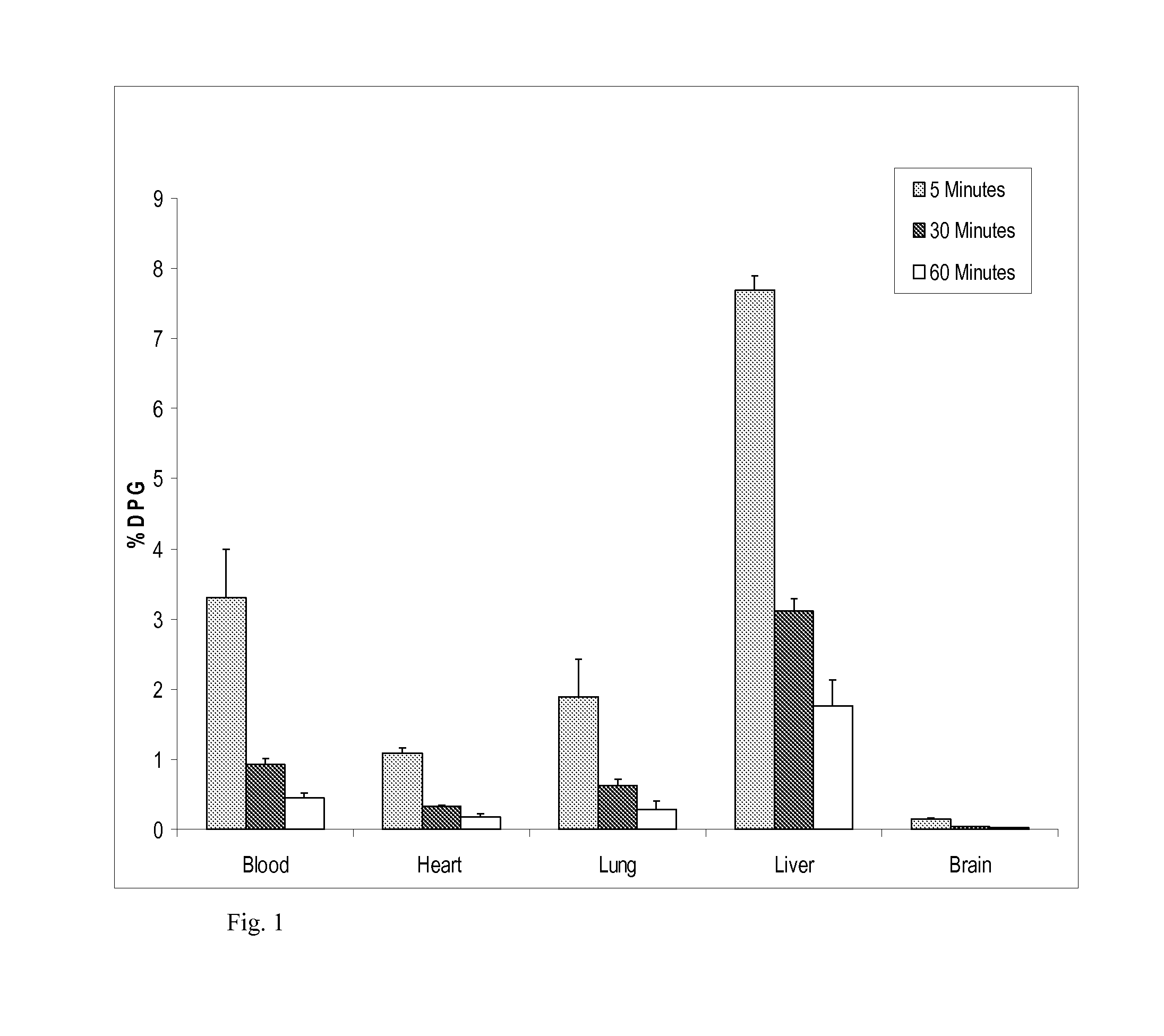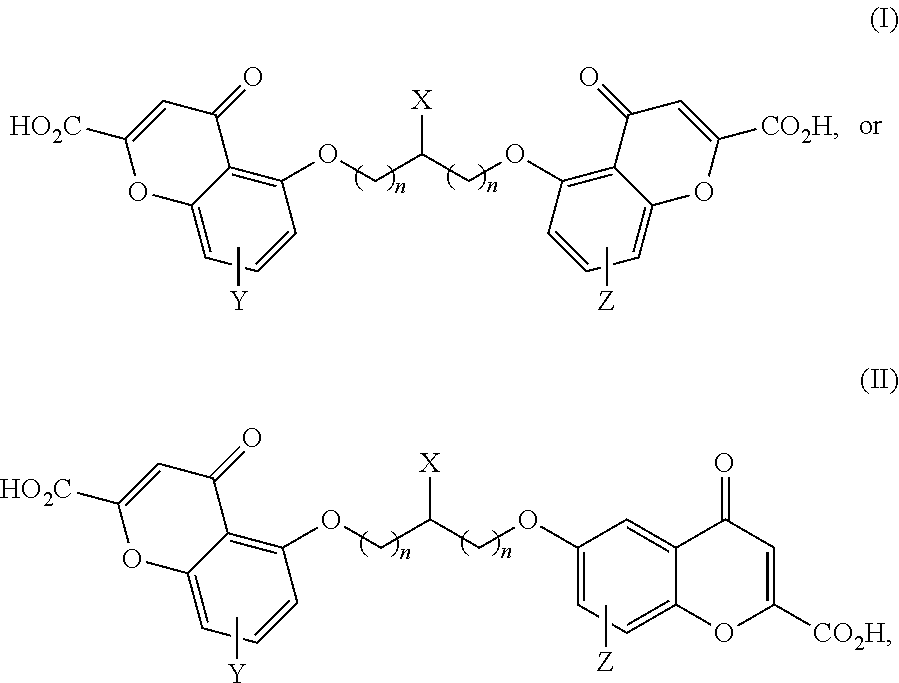Cromolyn derivatives and related methods of imaging and treatment
a derivative and derivative technology, applied in the field of medical imaging and disease treatment, can solve problems such as plaque buildup, and achieve the effect of efficient preparation of fluorinated compounds and faster synthesis and purification
- Summary
- Abstract
- Description
- Claims
- Application Information
AI Technical Summary
Benefits of technology
Problems solved by technology
Method used
Image
Examples
example 1
Synthesis of F-18 Labeled Cromolyn
[0078]Radiofluorination.
5,5′-(2-[18F]fluoropropane-1,3-diyl)bis(oxy)bis(4-oxo-4H-chromene-2-carboxylic acid)
[0079]A Wheaton 5-mL reaction vial containing 50 mCi of fluorine-18 in 1 mL of 18O-enriched water, Kryptofix-2.2.2. (6 mg), and potassium carbonate (2 mg) was heated at 120° C. and solvent was evaporated with the aid of nitrogen gas. The K18F / Kryptofix complex was dried three times at 120° C. by the addition of 1 mL of acetonitrile followed by evaporation of the solvent using a nitrogen flow. A solution of 1,3-bis[tolylsulfonyl)oxy]-2-[(trifluoromethyl)sulfonyl]oxy-propane (4 mg) in acetonitrile was added to the vial and fluorination was performed at 80° C. for 10 min. The resultant 2-[18F]fluoropropane 1,3-ditosylate solution (90% r×n, radioTLC) was passed through a silica gel SepPak using methylene chloride into a vial containing K2CO3 (10 mg) and ethyl 5-hydroxy-4-oxo-4H-chromene-2-carboxylate (10 mg). After solvent removal, N-methyl-2-pyrr...
example 2
Synthesis of Precursors
[0080]
2-Carbethoxy-5-hydroxy-γ-chromone
[0081]A mixture of 2,6-dihydroxyacetophenone (1.0 g, 6.6 mmol) and ethyl oxalate (0.15 g, 6.6 mmol) in ether (10 mL) was added to a solution of sodium ethoxide (0.4 g Na, 20 mmol) in ethanol (15 mL). The mixture was stirred at 25° C. for 30 min, heated at reflux for 1.5 hr, cooled and filtered. The precipitated sodium salt was washed with ether and dried. It was then dissolved in water and acidified with 10% HCl to form a sticky solid. The solid was refluxed in ethanol (20 mL) with a catalytic amount of 36% HCL for 1 hr. The mixture was poured into 50 mL of water and extracted twice with methylene chloride (50 mL). The extracts were combined and dried. After solvent removal, the crude material was chromatographed on silica gel (ethyl acetate / hexane 20:80) to yield 0.57 g (40%) of a yellow product; mp 146-148° C. (Lit. 148° C.); 1H NMR (CDCl3), d 1.42 (t, 3H, J=7.14 Hz, CH3), 4.47 (q, 2H, J=7.14 Hz), 6.82 (d, 2H, J=8.24 Hz...
example 3
Synthesis of Standard
5,5′-(2-fluoropropane-1,3-diyl)bis(oxy)bis(4-oxo-4H-chromene-2-carboxylic acid)
[0085]
1,3-Bis(2-acetyl-3-hydroxyphenoxy)-2-fluoropropane
[0086]A mixture of 3-bis(4-methylbenzenesulfonate)-2-fluoropropanediol (1.0, 2.5 mmol), 2,6-dihydroxyacetophenone (0.76 g, 5.0 mmol) and potassium carbonate (0.69 g) in acetonitrile (40 mL) was heated under reflux for 16 hr. The mixture was filtered and the filtrate was evaporated. The crude material was chromatographed on silica gel (acetonitrile / methylene chloride 5:95) to yield 0.57 g (40%) of product; mp 162-165° C.; 1H NMR (d6-DMSO), δ 2.5 (s, 6H, 2CH3), 4.38 (m, 4H, 2CH2), 5.22 (br d 1H, J=49 Hz, CHF), 6.45 (m, 4H, 4Aro-H), 7.28 (t, 2H, J=4.55 Hz, 2Aro-H).
1,3-Bis(2-carboxychromon-5-yloxy)-2-fluoropropane diethyl ester
[0087]A mixture of 1,3-bis(2-acety-3-hydroxyphenoxy)-2-fluoropropane (200 mg, 0.52 mmol) and ethyl oxalate (2 mL) was added to a solution of sodium ethoxide (87 mg Na) in ethanol (10 mL) and benzene (10 mL). Th...
PUM
| Property | Measurement | Unit |
|---|---|---|
| pH | aaaaa | aaaaa |
| temperature | aaaaa | aaaaa |
| temperature | aaaaa | aaaaa |
Abstract
Description
Claims
Application Information
 Login to View More
Login to View More - R&D
- Intellectual Property
- Life Sciences
- Materials
- Tech Scout
- Unparalleled Data Quality
- Higher Quality Content
- 60% Fewer Hallucinations
Browse by: Latest US Patents, China's latest patents, Technical Efficacy Thesaurus, Application Domain, Technology Topic, Popular Technical Reports.
© 2025 PatSnap. All rights reserved.Legal|Privacy policy|Modern Slavery Act Transparency Statement|Sitemap|About US| Contact US: help@patsnap.com



